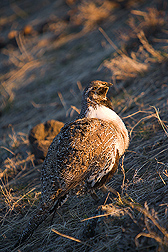This page has been archived and is being provided for reference purposes only. The page is no longer being updated, and therefore, links on the page may be invalid.
|
|
|
|
ARS Scientists Study Effects of Grazing on Grouse Habitat
By Ann PerryApril 30, 2010
Agricultural Research Service (ARS) scientists at the Eastern Oregon Agricultural Research Center in Burns, Ore., are taking a careful look at how grazing cattle affect sage-grouse habitat on high desert rangelands.
Cattle share this habitat with sage-grouse, which are chicken-sized birds that are notorious for the showy commotion they create during mating season. But the sage-grouse numbers have declined throughout their range, and the U.S. Fish and Wildlife Service (FWS) has added the species as a candidate for Endangered Species Act protection. FWS will review the status of the sage-grouse annually to determine whether it warrants more immediate attention for being listed as an endangered species.
If the sage-grouse is listed, this would increase scrutiny of management practices on rangelands that provide habitat for the species. The birds depend on sagebrush and the grasses growing beneath these shrubs to provide food and a safe place to nest and raise their young.
Ranchers worry that an increased emphasis on management for sage-grouse habitat could limit their use of rangelands. Such a limitation could seriously threaten the livelihood of ranchers who graze their animals on public lands.
ARS rangeland scientists David Ganskopp (now retired) and Chad Boyd studied cattle grazing patterns on sagebrush communities. They found that cattle first preferred to graze on perennial grass growing between sagebrush plants. These grasses between sagebrush plants were called “interspace” tussocks, which are the individual grass plants.
When cattle consumed around 40 percent of the interspace tussocks, they then began to graze on the tussocks growing beneath sagebrush itself. The researchers also noted that grass tussocks under spreading, umbrella-shaped shrub canopies were less likely to be grazed than tussocks beneath erect, narrow canopies.
Boyd and Ganskopp concluded that ranchers could preserve grouse habitat by monitoring the rate at which cattle were consuming interspace tussocks and moving them to new grazing lands when 40 percent of the interspace tussock had been consumed. Their findings also suggest that cattle impacts on grouse nesting habitats may be affected by site factors like sagebrush shape and stature that are not readily controlled with grazing management.
Results from this study were published in Rangeland Ecology & Management.
ARS is the principal intramural scientific research agency of the U.S. Department of Agriculture.

